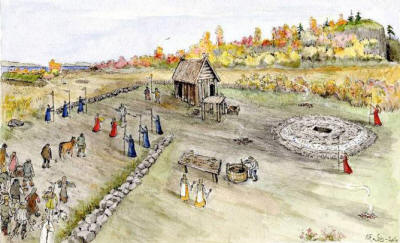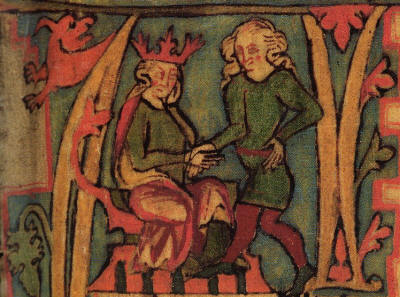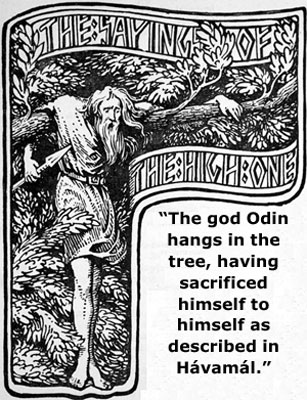|

by Acharya S/D.M. Murdock
16 March 2012
from
FreeThoughtNation Website
Spanish version

Artist's
rendering of the original 'god temple,' with sacrifice altar, staff
house in center
and procession on
road to left
(PHOTO: PREBEN RØNNE,
NTNU, VITENSKAPSMUSEET)
A fascinating discovery is shedding
light upon pre-Christian Scandinavian religion and early Christian
inroads into Norway.
In the Norwegian press, this highly
important find is being called "unparalleled," "first of its kind"
and "unique," said to have been "deliberately and carefully hidden"
- from invading and destructive Christians.
Located at the site of
Ranheim, about 10 kilometers south of the
Norwegian city of Trondheim, the astonishing discovery was unearthed
while excavating foundations for new houses and includes a "gudehovet"
or "god temple."
Occupied from the 6th or 5th century BCE
until the 10th century AD/CE, the site shows signs of usage for
animal sacrifice, a common practice among different peoples in
antiquity, including the biblical Israelites. (E.g.,
Num 7:17-88)
Over 1,000 years ago, the site was
dismantled and covered by a thick layer of peat, evidently to
protect it from marauding Christian invaders. These native Norse
religionists apparently then fled to other places, such as Iceland,
where they could re-erect their altars and re-establish the old
religion.
In "Unparalleled pagan sanctuary found," the Norwegian newspaper Aftenposten reports:
The pagan sanctuary survived because
the last people who used it over 1,000 years ago did their
utmost to hide the entire system with an unusually thick layer
of soil...
"The discovery is unique in a Norwegian context, the first ever
made in our latitudes," says Preben Rønne of the Science
Museum/University of Trondheim, who led the excavations.
Animal blood
sacrifice
The god temple may have been built sometime around or after the year
400 AD, thus used for hundreds of years until the people emigrated
to avoid Christianity's "straitjacket."
It consisted of a stone-set "sacrificial
altar" and also traces of a "pole building" that probably housed
idols in the form of sticks with carved faces of Thor, Odin, Frey
and Freya. Deceased relatives of high rank were also portrayed in
this way and attended.
Nearby, the archaeologists also
uncovered a procession route.
Thanks to the soil, the god temple was very well preserved. The
"altar" where one worshiped the gods and offered animal blood
consisted of a circular stone setting around 15 meters in diameter
and nearly a meter high. The pole building a few meters away was
rectangular, with a floor plan of 5.3 x 4.5 meters, and raised with
12 poles, each having a solid stone foundation.
The building may have been high and,
from the findings, was very clearly not used as a dwelling. Among
other reasons, it had no fireplace. Inside the "house" were found
traces of four pillars that may be evidence of a high seat where the
idols stood between ceremonies.
The processional road west of the temple
and headed straight towards the pole building was marked with two
parallel rows of large stones, the longest sequence at least 25 feet
long.
Strange burial
mound
When archaeologists began excavation work last year, the site was
thought at first to be a flat burial mound with a "master's grave"
and one or more secondary graves.
"But as we dug, the mound appeared
more and more strange," says Rønne.
"Approximately in the middle of the excavation, we had to admit
that it was not a burial mound but a sacrificial altar, in the
Norse sources called a 'horg.' It was made up of both round
'dome rocks' and stone slabs. During our work, we found two
glass beads, and also some burned bones and traces of a wooden
box that had been filled with red-brown sand/gravel and a
cracked boiling stone.
Among the bones, we found part of a
skull and several human teeth. However, we found no 'gold old
men,' small human figures of thin gold, which were often used in
connection with sacrifices."
The latest dating of the god temple is
between 895 and 990 AD. Precisely during this period Christianity
was introduced by heavy-handed methods into Norway.
This meant that many left the country to
retain their original god-belief.
"Probably the people who used the
temple were among those who chose to emigrate, either to Iceland
or other North Atlantic islands," said Rønne. "Posts for pole
building were in fact pulled up and removed.
The whole 'altar' was carefully
covered with earth and clay, precisely at the transition to
Christian times. Therefore, the cult site was completely
forgotten."
Unique in
Norway
Large pre-Christian cult sites in Scandinavia - often large
settlements with a large central hall, frequently with a smaller
attached building - have been found not in Norway, but, rather, in
Central and Southern Sweden (Skåne), also in eastern Denmark.
"In the sacrificial altar, we found
a fire pit that actually lay directly on the prehistoric plow
layer. The charcoal from this grave is now dated to 500-400 BC.
Thus, the place could have been
regarded as sacred or at least had a special status long before
the stone altar was built. In the prehistoric plow layer under
the fire pit, we could clearly see the traces of plowing with an
'ard,' a plow precursor," said Rønne.

Harald Fairhair.
King Haraldr hárfagri
receives the kingdom out of his father's hands.
From the 14th century
Icelandic manuscript Flateyjarbók,
now in the care of
the Árni Magnússon Institute in Iceland.
According to Rønne, it was easy to
interpret [the building] as a god temple from the Norse sources.
So it was also from precisely the
Trøndelag area that the largest exodus of people who would retain
their freedom and not become Christians took place. A large part of
them went to Iceland between 870 and 930 AD, i.e., during the time
of Harald Fairhair.
In all, 40 people from Trøndelag are
specifically mentioned in the Norse sources.
In Iceland, their
descendants later wrote a large part of these sources.
"Indications are that the people who
deliberately covered up the god temple at Ranheim took the posts
from the stave house/pole building, in addition to the soil from
the altar, to the place where they settled down and raised a new
god temple. Because our findings and the Norse sources work well
together, the sources may be more reliable than many scientists
believed," said Rønne.
Now the unique sanctuary of Ranheim may
be removed forever to make way for housing.
Not all are in
agreement:
"The facility will be a great
tourist attraction, if what has happened at the place is
disclosed. It is unique in Norway," says civil engineer Arvid
Ystad, who, in a private initiative, has applied both to the
Cultural Heritage and the Ancient Monuments Society for the
facility's conservation.
"The location of the [planned] housing could easily be adapted
to this unique cultural heritage [site], without anyone losing
their residential lots. It could be an attraction for new
residents, telling them much about the history of the facility
over 1000 years ago.
Unfortunately, housing construction is now
underway," said Rønne.
(translation from the
Norwegian by D.M. Murdock)
A side bar in the Aftenposten article
reiterates that the structure served not only for worship but also
to house the gods.
We further read:
The gods were Odin, Thor, Frey, often depicted as carved faces on
wooden columns that could be moved, worshiped and sacrificed to.
Ancestors were also depicted and worshiped. No such idols are
recorded in Norway because they were all destroyed by the
introduction of Christianity.
It seems a criminal act to allow this astonishing and precious site
to be destroyed as well!
Hopefully, the Norwegian government will
intervene to preserve this obvious World Heritage Site.
What is
'pre-Christian?'
In the Aftenposten article, this significant discovery at Ranheim is
hailed as a "pre-Christian place of worship," despite the fact that
the stone temple there has been dated to the fifth century AD/CE.
Over the centuries, it has been argued
fallaciously and erroneously that, simply because something
post-dates the "Christian" or common era - i.e., comes after the
year 1 AD/CE - it is therefore automatically "post-Christian." This
erroneous perception is raised in comparative-religion studies in
particular to suggest any possible borrowing to have been from
Christianity to Paganism, rather than the other way around.
Such a contention is false, as, in the first place, the dating
system of BC/AD was first devised in the sixth century by the
Christian monk Dionysius Exiguus (c. 470-544), based on Christian
beliefs, not on any discernible scientific facts.
We are therefore working with backdated
markers designed to make an artificial timeline supposedly created
by the Lord God himself, when he miraculously took birth through the
womb of a Jewish virgin girl.
In reality, no one in antiquity at the time was aware of this new
timeline suddenly appearing with the birth of the Lord of the
cosmos.
The Romans went right along using their
Julian calendar, while the Egyptians had their Alexandrian calendar,
as if nothing had happened. Indeed, they were completely unaware
that anything had happened.
Secondly, the "Christian" era does not begin in the year 1 AD/CE,
since, in reality, Christianity barely shows up in the historical
record until the second century.
A close inspection of the historical
record reveals that, other than various parts of some Pauline
epistles perhaps, there exists no credible, scientific evidence for
anyone having ever heard of a "Jesus the Christ" before the end of
the first century or early second. In addition, the earliest
references seem to be to a "Chrestos," not a "Christos."
In actuality, we possess no extant
physical artifacts from the first century at all that are
unambiguously Christian.
Hence, the "Christian era" essentially
did not even appear in the earliest places until the second century.
The magical
BC/AD indicator?
For many centuries after its inception, Christianity remained
unknown in countless places; hence, all those areas continued to be
pre-Christian.
For example, the European country of
Lithuania held off Christian incursions until the 14th century,
until which time, therefore, it was pre-Christian. Today, hundreds
of people in remote tribes remain "uncontacted," having never heard
of Christianity; thus, they too constitute pre-Christian cultures,
even though we are now more than 2,000 years past the magical BC/AD
marker.
This yardstick of the BC/AD timeline serving to prove whether or not
a parallel motif within comparative religion could be deemed
"pre-Christian" is therefore fallacious.
In determining possible influences in
either direction, from Paganism to Christianity or vice versa, we
must thus ask specifically what is the scientific evidence of when
Christianity could possibly have influenced a particular culture?
To rely on the artificial BC/AD dividing
line ranks as unscientific.
Continued
vandalism of the past
In this Norwegian discovery, we evidently possess a genuinely
pre-Christian site, a contention demonstrated by the fact that the
site was covered over apparently to prevent its destruction by
Christians.
The fact that this important discovery
is to be destroyed by a housing project also provides an example of
why so much archaeological evidence of pre-Christian religion and
mythology is no longer available to us. In the past, the destruction
was often deliberate, frequently with Christian sites located on top
of pre-Christian pagan places of worship, which is why this site was
hidden, apparently, and why we can be certain that it ranks as
pre-Christian.
When the stone temple was built, the
monk Dionysius had not yet determined the "Christian" era by
devising his timeline.
To many cultures, the
pre-Christian/post-Christian timeline was not something in writing
but depended on whether or not Christians had invaded their lands,
slaughtered the people and destroyed their temples.
It should be noted further that this site was evidently sacred for
at least eight or nine hundred years before the stone temple was
constructed. It is possible that the germ of
Norse mythology and
religion was practiced by the people who used this site in the
first millennium BCE.
For this reason, as well as the fact
that many religious ideas date back thousands of years, the claim
ranks as fallacious that, simply because a comparative-religion
theme post-dates the "Christian" era, it was necessarily influenced
by Christianity.
If there are no overt Christian
influences, it is often likely that the motif pre-dates the invasion
of Christianity into the era and culture in question.
Norse
mythology parallels to Christianity

'The Elder or Poetic
Edda'; commonly known as Sæmund's Edda.
Edited and translated
with introduction and notes by Olive Bray.
Illustrated by W.G.
Collingwood (1908) Page 61.
In this regard, Scandinavian religion
and mythology possess intriguing similarities to Christian doctrine
and tradition, as related in my book
Who Was Jesus?
(250):
In some of the cultures of the Roman
Empire at the time, there evidently were other gods and
sacrificial victims who were likewise portrayed as having been
"side-wounded," including the Norse Father-God Odin, who was
hung on a tree and wounded with a spear....
Much like the Christian father-god incarnated in Christ, in the
Norse mythology Father Odin is depicted as hanging on the
"world-tree" in an act of sacrifice, while wounded by a spear.
The old Norse text the Havamal, one
of the Norse (prose) Eddas, contains a poem called the Runatal,
stanza 138, in which Odin says:
"I know that I hung, on a windy
tree, for all of nine nights, wounded with a spear, and
given to Óðinn, myself to myself, on that tree, which no man
knows, from what roots it runs."
(Thorgeirsson)
Furthermore, the "All-Father" god Odin's
invincible and beloved son, Balder, is pierced with a spear of
mistletoe.
Although Balder dies, in the time of
the Ragnarok or
Norse "apocalypse," he will be reborn or resurrected. This latter motif is similar to Christ's
"Second Coming" depicted in Revelation.
Moreover, as
Jesus is the "Light of the World," so Balder is the
"god of light." In this way, Balder is the savior of the world who
brings peace. Like Jesus and the Twelve, Balder is also depicted
with "12 knights."
Although
the Runatal poem was only written down in the 13th
century AD/CE, parts of it are traceable to at least the 9th
or 10th centuries, possibly before Christianity invaded
the relevant Norse area and drove away the practitioners of the old
religion.
There is no clear indication of
Christian influence on the Norse stories - other than the parallels
- and the fact that the earliest extant accounts we possess with
such details come from centuries after the so-called Christian era
does not necessarily mean that these myths are post-Christian.
In reality, there is little here that
must have come from Christianity, as these various motifs represent
nature-worship and astral mythology or
astrotheology, and can be
found abundantly in even older mythological systems.
The Mythical
Twelve
For example, in the Scandinavian myth we find the motif of "the
Twelve," with the "god of light" surrounded by "12 knights."
Immediately recognizable is not only the
story of Christ and the 12 disciples but also King Arthur and the 12
knights of the Round Table. The configuration of a divine or
legendary personage with 12 other figures, whether human or
otherwise, represents a common formula that predates Christianity by
eons.
Numerous such configurations of "the Twelve"
can be found
throughout antiquity, including in the Bible.
There is no reason at all to contend
that this Norse motif was founded upon Christianity.
On the contrary, there is every reason
to suspect that the Christian 12 (+1) is based on the old formula,
which in turn revolves significantly around the sun:
the "light of
the world" and "god of light," surrounded by the signs of the
zodiac, months of the year, hours of day and night, etc.
The fact that there are 12 pillars or poles at this pre-Christian
temple site indicates this popular 12 configuration.
Architectural
layouts with 12 divisions can be found in much older structures such
as the
Horus temple at Tharo, Egypt (c. 1,000 BCE).
Hence, it would appear that the story of
Balder the savior and the 12 subordinates, as well as the 12 names
of Odin and the 12 gods of Asgard - possibly represented at Ranheim
in the 12 pillars - emanate not from Christianity but from this
millennia-old tradition.
While
the ancient Norse needed to cover up their sacred sites in
order to protect them from Christian marauders, centuries later
Christian apologists attempt to keep pre-Christian mythology buried,
with all manner of fallacious arguments and calumny.
Further such vandalism and suppression
of the ancient Norwegian heritage should not be allowed, and this
amazing temple site should be preserved.
|



